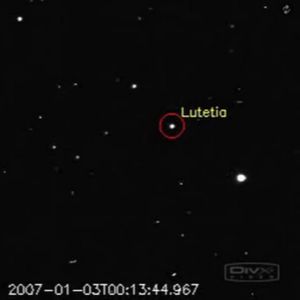Centauri Dreams‘ view is that the more we can learn about asteroids, the better. And the interest isn’t purely scientific. One day we may have to set about nudging an approaching asteroid so as to prevent a collision with Earth, and if that day comes, we’ll need to have a plan in place that depends upon a thorough understanding of these objects and their composition. In the long run, asteroid studies are anything but optional.
The European Space Agency’s Rosetta mission is filling in some of the gaps enroute to comet 67P Churyumov-Gerasimenko. In its sights are two asteroids — 2867-Steins and 21-Lutetia — orbiting between Mars and Jupiter. We’ll learn a lot more about both between now and July of 2010, by which time Rosetta will have viewed each at close range.
Meanwhile, the spacecraft has taken a first look at 21-Lutetia using the onboard OSIRIS (Optical, Spectroscopic, and Infrared Remote Imaging System) instruments. At the time of its observations, the vehicle was roughly 245 million kilometers from the asteroid, which shows up as little more than a bright spot in the early imagery.
So what is Rosetta up to here? The early observations are intended to study the rotation of the 100-kilometer object, analyzing the changes in the intensity of light reaching the instrument. Up next for Rosetta: a swing past Mars that will slingshot the spacecraft toward Earth for yet another gravity assist this coming November. The ultimate objective when the comet is reached is to land a probe on the surface of 67P/Churyumov-Gerasimenko, followed by a two year study.
Image: Asteroid 21-Lutetia, as seen by the spacecraft from a distance of about 245 million kilometres, during a remote-sensing observation campaign of this object that lasted 36 hours. Click on the image to see ESA’s animation of the observing session (and note the occasional flashes, which are the result of cosmic rays hitting the OSIRIS detectors). Credit: ESA/MPS/UPD/LAM/IAA/RSSD/INTA/UPM/DASP/IDA.



Hi Paul
Comets are a diverse bunch, so Rosetta should be full of surprises. Four comets have been imaged up close – Halley, Wild 2, Borrelly and Temple 1 – and all have been weirdly different. Another spanner in the works of systematica typology of comets is the recent discovery of “asteroids” in the Main Belt suddenly sprouting tails – Main Belt Comets they’re called now. Weird. Doubtless a lot of asteroids are deactivated comets, coated in oily-dust (asphalt) and chilly enough not to spew forth tails.
It’s a shame current space-plans don’t factor in the volatile wealth in an inactive comet – several Near Earth Objects are almost certainly comets, within easy reach of a manned mission. In spite of its other virtues the Moon is really as dry as the Atacama desert in a dry patch and as short on organic material. An asphalt coated comet couldn’t be more different.
Adam
Yes, and as you say, Adam, these are relatively easy targets, a good place to check out hardware for Mars and later on top of all their other virtues. Would love to see a near-term mission to an inactive comet.
Rosetta awakes from hibernation for asteroid encounter
3 July 2008
Spacecraft controllers have just awoken Rosetta from hibernation
to prepare for its encounter with asteroid (2867) Steins on 5
September.
ESA’s comet chaser will study the relatively rare asteroid as it flies
by on its way to comet 67/P Churyumov-Gerasimenko in 2014.
http://www.esa.int/SPECIALS/Rosetta/SEMQPDSHKHF_0.html
Ultraviolet and visible photometry of asteroid (21) Lutetia using the Hubble Space Telescope
Authors: H.A. Weaver, P.D. Feldman, W.J. Merline, M.J. Mutchler, M.F. A’Hearn, J.-L. Bertaux, L.M. Feaga, J.W. Parker, D.C. Slater, A.J. Steffl, J.D. Drummond, S.A. Stern
(Submitted on 23 Dec 2009)
Abstract: The asteroid (21) Lutetia is the target of a planned close encounter by the Rosetta spacecraft in July 2010. To prepare for that flyby, Lutetia has been extensively observed by a variety of astronomical facilities.
We used the Hubble Space Telescope (HST) to determine the albedo of Lutetia over a wide wavelength range, extending from ~150 nm to ~700 nm. Using data from a variety of HST filters and a ground-based visible light spectrum, we employed synthetic photometry techniques to derive absolute fluxes for Lutetia.
New results from ground-based measurements of Lutetia’s size and shape were used to convert the absolute fluxes into albedos. We present our best model for the spectral energy distribution of Lutetia over the wavelength range 120-800 nm.
There appears to be a steep drop in the albedo (by a factor of ~2) for wavelengths shorter than ~300 nm. Nevertheless, the far ultraviolet albedo of Lutetia (~10%) is considerably larger than that of typical C-chondrite material (~4%).
Lutetia’s reflectivity is not consistent with a metal-dominated surface at infrared or radar wavelengths, and its albedo at all wavelengths (UV-visibile-IR-radar) is larger than observed for typical primitive, chondritic material.
We derive a relatively high FUV albedo of ~10%, a result that will be tested by observations with the Alice spectrograph during the Rosetta flyby of Lutetia in July 2010.
Comments: 14 pages, 2 tables, 8 figures
Subjects: Earth and Planetary Astrophysics (astro-ph.EP)
Cite as: arXiv:0912.4572v1 [astro-ph.EP]
Submission history
From: Harold Weaver Jr [view email]
[v1] Wed, 23 Dec 2009 06:24:24 GMT (913kb)
http://arxiv.org/abs/0912.4572